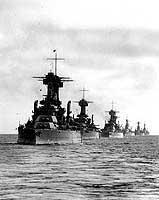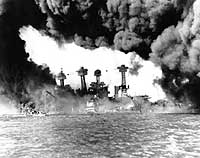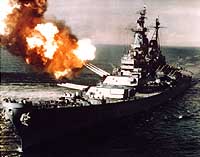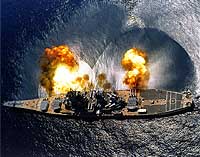
U.S. Navy battleship construction began with the keel laying of the Maine in 1888 and ended with the suspension of the incomplete Kentucky (BB-66) in 1947. During this almost six-decade-long era, 59 battleships of 23 different basic designs (or "classes") were completed for the Navy. Another twenty battleships and battle cruisers (three more "classes") were begun or planned, but not completed.
Though the building rate averaged almost exactly one per year, it was not a steady process, but was concentrated in two phases. The first, corresponding to the rise of the United States to first-class naval rank, began in 1888 and came to an abrupt halt with the signing of the Naval Limitations Treaty in 1922. The second building phase began in 1937 and was effectively finished in 1944 with the commissioning of USS Missouri (BB-63), the last of ten battleships completed during this period.
These warships can be conveniently divided into four main groups:
Except for the fast Lexington Class battle cruisers and Iowa Class battleships, these were all relatively slow vessels, as heavily armored as they were armed, intended primarily to steam in formation with their "sisters" and slug it out with similar opponents, using their powerful guns to settle the matter. In their day, they were the "Queens of the Sea", the foundation of national strategic offense and defense. That "day" ended only with the arrival, effectively just before the start of World War II, of aircraft that could not only out-range the big guns, but also deliver blows of equal or greater power. Thereafter, at least in the daylight when the planes could fly, battleships performed as auxiliaries to aircraft carriers.
The Second World War brought another mission, shore-bombardment, in which the fire of heavy guns was precisely directed against enemy facilities ashore, to pave the way for invasion or to simply destroy war-making potential. This justified the retention of the big-gun ships in the post-war era and brought them back to active duty on three different occasions. Until 2006, six decades after the last U.S. Navy battleship was completed, two were kept on the Naval Vessel Register for possible future employment in that role.
This page features selected photographs of U.S. Navy battleships, and provides links to more extensive pictorial coverage of the individual battleship classes.
For images related to specific classes of U.S. Navy battleships,
see:
Though the Alaska class large cruisers (CB-1 through CB-6) of 1941 are actually part of the cruiser design lineage, some sources persist in (mistakenly) referring to them as "battle cruisers". Accordingly, a link is provided here to their class page.
| If you want higher resolution reproductions than the digital images presented here, see: "How to Obtain Photographic Reproductions." |
Click on the small photograph to prompt a larger view of the same image.
|
Photo #: NH 553 USS Connecticut (BB-18) Running speed trials off the Maine coast, 1906. Photographed by Enrique Muller. Note sailors crowding the rails, watching the photographer's boat, which is about to be swamped by the battleship's bow wave. U.S. Naval History and Heritage Command Photograph. Online Image: 117KB; 740 x 620 pixels |
 |
|
Photo #: 19-N-61-6-25 USS Michigan (BB 27) Fully dressed with flags and with her crew manning the rails, during the naval review off New York City, 3 October 1911. Photograph from the Bureau of Ships Collection in the U.S. National Archives. Online Image: 84KB; 740 x 610 pixels Reproductions of this image may also be available through the National Archives photographic reproduction system. |
 |
|
Photo #: NH 2792 USS Texas (BB-35) Firing her 14"/45 main battery guns, during long range battle practice, February 1928. U.S. Naval History and Heritage Command Photograph. Online Image: 118KB; 740 x 580 pixels |
 |
|
Photo #: 80-G-695093 The United States Battle Fleet Steaming in column off the California coast during the middle or later 1920s. The three leading ships are (in no particular order) Colorado (BB-45), Maryland (BB-46), and West Virginia (BB-48), followed by Tennessee (BB-43) and three older battleships. Photograph taken from USS California (BB-44). Official U.S. Navy Photograph, now in the collections of the National Archives. Online Image: 106KB; 590 x 765 pixels Reproductions of this image may also be available through the National Archives photographic reproduction system. |
 |
|
Photo #: 80-G-463589 USS Arizona (BB-39) Pitching in heavy seas during the 1930s. Official U.S. Navy Photograph, now in the collections of the National Archives. Online Image: 86KB; 740 x 610 pixels Reproductions of this image may also be available through the National Archives photographic reproduction system. |
 |
|
Photo #: NH 94378 Pearl Harbor Attack, 7 December 1941 Battleships West Virginia (BB-48) (sunken at left) and Tennessee (BB-43) shrouded in smoke following the Japanese air raid. Courtesy of the U.S. Naval Institute Photograph Collection. U.S. Naval History and Heritage Command Photograph. Online Image: 87KB; 740 x 610 pixels |
 |
|
Photo #: 80-G-291047 USS New Jersey (BB-62) In a stiff storm in the western Pacific, 8 November 1944. Photographed from USS Intrepid (CV-11). USS Hancock (CV-19) is in the background. Official U.S. Navy Photograph, now in the collections of the National Archives. Online Image: 110KB; 740 x 610 pixels Reproductions of this image may also be available through the National Archives photographic reproduction system. |
 |
|
Photo #: 80-G-K-6035 (Color) Bombardment of Kamaishi, Japan, 14 July 1945 USS Indiana (BB-58) fires a salvo from her forward 16"/45 guns at the Kamaishi plant of the Japan Iron Company, 250 miles north of Tokyo. A second before, USS South Dakota (BB-57), from which this photograph was taken, fired the initial salvo of the first naval gunfire bombardment of the Japanese Home Islands. The superstructure of USS Massachusetts (BB-59) is visible directly behind Indiana. The heavy cruiser in the left center distance is either USS Quincy (CA-71) or USS Chicago (CA-136) . Official U.S. Navy Photograph, now in the collections of the National Archives. Online Image: 101KB; 740 x 505 pixels Reproductions of this image may also be available through the National Archives photographic reproduction system. |
 |
|
Photo #: 80-G-490436 USS Missouri (BB-63) Anchored in Sagami Wan or Tokyo Bay, Japan, with other units of the U.S. Third Fleet, 30 August 1945. Mount Fujiyama is faintly visible in the distance. Missouri is flying Admiral William F. Halsey's four-star flag. Official U.S. Navy Photograph, now in the collections of the National Archives. Online Image: 69KB; 740 x 615 pixels Reproductions of this image may also be available through the National Archives photographic reproduction system. |
 |
|
Photo #: 80-G-K-12603 (Color) USS Missouri (BB-63) Fires a salvo of 16-inch shells from turret # 2 while bombarding Chongjin, North Korea, in an effort to cut enemy communications, October 1950. Chongjin is only 39 miles from North Korea's northern border. This is a color-tinted version of a black & white original. The original photograph is Photo #: 80-G-421049. Official U.S. Navy Photograph, now in the collections of the U.S. National Archives. Online Image: 84KB; 740 x 605 pixels Reproductions of this image may also be available through the National Archives photographic reproduction system. |
 |
|
Photo #: DN-ST-85-05379 (Color) USS Iowa (BB-61) Fires a full broadside of nine 16"/50 and six 5"/38 guns during a target exercise near Vieques Island, Puerto Rico, 1 July 1984. Photographed by PHAN J. Alan Elliott. Note concussion effects on the water surface, and 16-inch gun barrels in varying degrees of recoil. Official U.S. Navy Photograph, from the the Department of Defense Still Media Collection. Online Image: 183KB; 740 x 605 pixels |
 |
For images related to specific classes of U.S. Navy battleships,
see:
Though the Alaska class large cruisers (CB-1 through CB-6) of 1941 are actually part of the cruiser design lineage, some sources persist in (mistakenly) referring to them as "battle cruisers". Accordingly, a link is provided here to their class page.
NOTES:
| If you want higher resolution reproductions than the digital images presented here, see: "How to Obtain Photographic Reproductions." |
Page made 10 May 2000
Coding and introductory text updated 11 May 2009